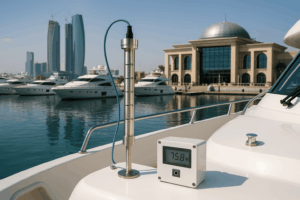Why Gdansk Port Needs Smart Tank Level Gauging Systems for Safer Ship Operations?

Gdansk Port stands as a major hub for maritime trade in Europe. With thousands of ships docking yearly, smooth operations are vital. Managing fuel, ballast, and fresh water on these vessels is a serious task. This is where a smart tank level gauging system makes a huge difference.
Using advanced sensors, these systems deliver real-time tank data. Ships can then manage fluids precisely, preventing overflows, leaks, or shortages.
Real-Time Monitoring Ensures Safer Operations:
Tank level sensors track fluid levels every second. If anything unusual happens, alarms go off instantly. Because of this quick alert system, crews can act fast and avoid major accidents.
Moreover, the digital displays are easy to read. Ship teams always know the exact status of each tank without the need for manual checks.
Remote Access Saves Time and Costs:
Modern tank systems offer remote monitoring. Officers can view tank data through phones or computers, even when away from the vessel. As a result, they can quickly adjust operations if something goes wrong.
All tank data is logged automatically. This helps a lot during inspections and saves hours of paperwork. With remote valve and pump control, operations at Gdansk Port become much more efficient.
Supporting Eco-Friendly Shipping:
Accurate tank management reduces risks of spills. This protects the environment around Gdansk Port. Plus, it helps ships meet international safety standards like IMO and SOLAS.
Clean operations, less waste, and safer seas — all thanks to smart tank level gauging.
Benefits of Tank Level Gauging at a Glance:
-
Real-time fluid level updates
-
Instant alarms for quick response
-
Remote monitoring and control
-
Easy compliance with marine laws
-
Smooth and efficient ship handling
Frequently Asked Questions (FAQs):
1. What is a smart tank level gauging system?
It’s a system that measures tank fluid levels using sensors and digital displays.
2. Why is it needed at Gdansk Port?
To ensure fast, safe, and eco-friendly ship operations.
3. What fluids does it monitor?
Fuel, ballast water, potable water, and wastewater.
4. Can it work during storms?
Yes, modern sensors deliver accurate readings even in rough seas.
5. Who checks the system onboard?
Crew members and remote operators monitor it.
6. How often should it be serviced?
It’s recommended to check systems yearly or before major trips.
7. Can older ships be upgraded?
Yes, many retrofit options are available for older vessels.
8. How does remote monitoring help?
It saves time and reduces the need for manual tank checks.
9. Is it eco-friendly?
Absolutely, it helps prevent spills and protects the sea.
10. Does it meet marine regulations?
Yes, it complies with international standards like SOLAS and IMO.


Latest Products
Onwa KM-8X 5-in-1 Marine Bundle Set Radome – GPS, Chartplotter, EchoSounder, AIS, Radar
8-inch GPS Chart Plotter with AIS and Radar
Onwa KM-8A (BUNDLE) 8-inch Color TFT LCD GPS Chart Plotter with Class B+ AIS Transponder MFD [BUNDLE]
Onwa KM-8C 8-inch Color TFT LCD GPS Chart Plotter with EchoSounder MFD